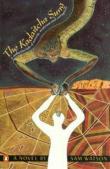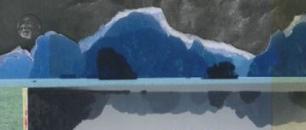AustLit
Latest Issues
AbstractHistoryArchive Description
"The Kadaitcha Sung tells the story of Tommy Gubba, son of Koobara, son of the chief of the Kadaitcha clan, and Fleur, a white woman, of Northern European descent. Tommy was born secretly after his uncle Booka Roth killed his father to become the last of the Kadaitcha clan. The Kadaitcha clan is in the novel an "ancient clan of sorcerers" (1) called by Biamee to stand among the tribes of the South Land (i.e. Australia) when he returned among the stars. Tommy is initiated and called by Biamee to recuperate the heart of the Rainbow Serpent stolen by Booka Roth, without which Biamee cannot "complete his earthly manifestation". Ensuing from the war that Booka waged against his own people, the veil of mists that Biamee had set upon the South Land is lifted, and "other mortals" come from "all corners of the globe and from every branch of the family of man" (33) and join forces with Booka, defeating the tribes of South Land that cannot match the weapons of the invaders (34). Tommy is to take revenge on the migloo ("fair-skinned" people), who have "raped and pillaged" (31) his people, and conquered the entire land (35). A fast pace narrative, The Kadaitcha Sung is also an action-packed novel, to which this quick introduction cannot do justice."
Source: Estelle Castro, 'Imaginary (Re)Vision', 2007
Notes
-
Dedication: To Catherine, Wagan and Mai-Ra. Into that place where reigned chaos and despair, You brought love and hope and Laughter so rare. Thank you...
Publication Details of Only Known VersionEarliest 2 Known Versions of
Other Formats
- Also sound recording.
Works about this Work
-
'Dystopia' : A History of the Genre in (and) Australia
2020
single work
criticism
— Appears in: Beyond the Dark : Dystopian Texts in the Secondary English Classroom 2020; (p. 8-34) -
The Kadaitcha Sung
i
"A black feather",
2017
single work
poetry
— Appears in: Australian Book Review , September no. 394 2017;Akhurst reads a poem inspired by Sam Watson's novel The Kadaitcha Sung and explains its genesis and the importance of the book to his own writing.
-
Australian Indigenous Art and Literature
2017
single work
criticism
— Appears in: Worldmaking : Literature, Language, Culture 2017; (p. 107-116) -
The Kadaitcha Sung : Towards Native Slipstream
2017
single work
criticism
— Appears in: Futuristic Worlds in Australian Aboriginal Fiction 2017; (p. 159-188)'Sam Watson is a well-known activist, lecturer, poet, novelist, playwright and film producer from the Birri-Gubba and Munaldjali nations. He belongs to the generation of Aboriginal activists and spokespeople who paved the way for future generations, with his active engagement in 1960s political activism against the White Australia Policy, the 1967 Referendum, the Gurindji land rights struggle, and more recently, advancing Aboriginal access to legal, medical and housing services. Amidst these political and cultural engagements, Watson wrote The Kadaitcha Sung . The novel was published in 1990 and generated a cornucopia of responses. As a “pre Master-of-the- Ghost-Dreaming ” novel, The Kadaitcha Sung was an Aboriginal literary novum, as there was nothing to prepare the reader for such a hybridity of genres used to speak bluntly about colonisation. Even when Mudrooroo’s Master appeared a year later, in 1991, the magical realist work was an easy read compared to Watson’s The Kadaitcha Sung . This contributed to one of the novel’s distinctive aspects: even though it has long since been out of print, it is still being discussed by new generations of scholars. No other pre twenty-first-century Aboriginal novel has attracted attention for so long.'
-
The Fantastic as a Terminological Trickster
2017
single work
criticism
— Appears in: Futuristic Worlds in Australian Aboriginal Fiction 2017; (p. 41-70)'In the opening pages of The Fantastic: A Structural Approach to a Literary Genre (1973), Todorov evokes the image of a tiger to draw a parallel between changes in the biological and literary “species”:
Being familiar with the species tiger, we can deduce from it the properties of each individual tiger; the birth of a new tiger does not modify the species in its definition. […] The same is not the case in the realm of art or of science. Here evolution operates with an altogether different rhythm: every work modifies the sum of possible works, each new example alters the species. (6)' (Introduction)
-
About Books
1990
single work
review
— Appears in: National Library of Australia News , October vol. 1 no. 1 1990; (p. 8-11)
— Review of The Kadaitcha Sung 1990 single work novel ; Reaching Tin River 1990 single work novel ; Sheep and the Diva : Stories 1990 selected work short story ; The Mighty World of Eye : Stories, Anti-Stories 1990 selected work short story criticism ; Isobars 1990 selected work short story ; Charades 1988 single work novel ; The Great World 1990 single work novel ; Flying Lessons 1990 single work novel ; Invisible Histories 1989 selected work short story poetry biography ; Marriages 1990 selected work short story ; Ingelba and the Five Black Matriarchs 1990 single work life story ; The Story of the Year of 1912 in the Village of Elza Darzins : A Novel 1990 single work novel ; A Body of Water : A Year's Notebook 1990 selected work autobiography short story poetry diary ; Smyrna : A Novel 1989 single work novel -
Much More to Tell You
1990
single work
review
— Appears in: Australian Bookseller & Publisher , May vol. 69 no. 1004 1990; (p. 23-24)
— Review of The Kadaitcha Sung 1990 single work novel -
Echoes of Dark Realities
1990
single work
review
— Appears in: The Age , 14 July 1990; (p. 9)
— Review of The Kadaitcha Sung 1990 single work novel -
Mood Musics of the Spiritual
1990
single work
review
— Appears in: The Weekend Australian , 28-29 July 1990; (p. rev 6)
— Review of The Kadaitcha Sung 1990 single work novel ; Mood Indigo 1990 single work novel -
The Latest in Paperbacks
1990
single work
review
— Appears in: The Courier-Mail , 28 July 1990; (p. 6)
— Review of The Kadaitcha Sung 1990 single work novel -
y
 The Circle and the Spiral : A Study of Australian Aboriginal and New Zealand Maori Literature
The Circle & the Spiral
Amsterdam
New York (City)
:
Rodopi
,
2004
Z1106371
2004
multi chapter work
criticism
The Circle and the Spiral : A Study of Australian Aboriginal and New Zealand Maori Literature
The Circle & the Spiral
Amsterdam
New York (City)
:
Rodopi
,
2004
Z1106371
2004
multi chapter work
criticism
From publisher's blurb: 'In Aboriginal and Maori literature, the circle and the spiral are the symbolic metaphors for a never-ending journey of discovery and rediscovery. The journey itself, with its indigenous perspectives and sense of orientation, is the most significant act of cultural recuperation. The present study outlines the fields of indigenous writing in Australia and New Zealand in the crucial period between the mid-1980s and the early 1990s - particularly eventful years in which postcolonial theaory attempted to "centre the margins" and indigenous writers were keen to escape the particular centering offered in seach of other positions more in tune with their creative sensibilities. Indigenous writing relinquished its narrative preference for social realism in favour of traversing old territory in new spiritual ways; roots converted to routes.' ... The Circle and the Spiral looks for 'locally and culturally specific tracks and traces that lead in other directions than those catalogued by postcolonial convention. This agenda is pursued by means of searching enquiries into the historical, anthropological, political and cultural determinants of the present state of Aboriginal and Maori writing (principally fiction).'
-
Harmony and Discord : Evocations of Hybridity in Theory, Culture, and Australian Magical Realism
2004
single work
criticism
— Appears in: Antithesis , no. 14 2004; (p. 111-123) -
Authorising Sacredness : On Storytelling, Fiction and Uluru
Ken Gelder
,
J. M. Jacobs
,
1998
single work
criticism
— Appears in: Uncanny Australia : Sacredness and Identity in a Postcolonial Nation 1998; (p. 97-116) -
Globalizing Indigenes : Postcolonial Fiction from Australia, New Zealand and the Pacific
2006
single work
criticism
— Appears in: JASAL , no. 5 2006; (p. 121-133)Wevers proposes that 'there are complex unfoldings around indigeneity, globalisation and the postcolonial which might usefully be illuminated by a consideration of some texts from Australia, Aotearoa/New Zealand and the Pacific.'
Wevers investigation leads her to conclude that 'Indigeneity is always placed; its politics, worldview and social order are site- and culturespecific, but in the unfolding of many indigenous texts a new discourse is appearing, in which the nation state and its long binarising history of "natives" is only one part of the scene, and where "indigeneity" re-articulates and responds to globalised discourses, one of which is postcolonial politics.'
-
The 'Sacred Heart' : Sam Watson's The Kadaitcha Sung
2008
single work
criticism
— Appears in: Studies in Australian Weird Fiction , no. 2 2008; (p. 39-48) 'This paper surveys how Sam Watson has reworked the notion of a dead heart [of Australia] in his fantasy novel The Kadaitcha Sung, by populating the land with the spirits of murdered Indigenous people and also presenting the landscape, and particularly Uluru, as the sacred setting of power and restoration' (39).
Awards
- Queensland,




